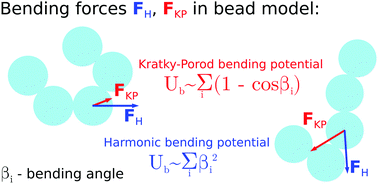当前位置:
X-MOL 学术
›
Soft Matter
›
论文详情
Our official English website, www.x-mol.net, welcomes your
feedback! (Note: you will need to create a separate account there.)
Different bending models predict different dynamics of sedimenting elastic trumbbells†
Soft Matter ( IF 2.9 ) Pub Date : 2018-06-26 00:00:00 , DOI: 10.1039/c8sm00604k Marek Bukowicki 1, 2, 3, 4 , Maria L. Ekiel-Jeżewska 1, 2, 3, 4
Soft Matter ( IF 2.9 ) Pub Date : 2018-06-26 00:00:00 , DOI: 10.1039/c8sm00604k Marek Bukowicki 1, 2, 3, 4 , Maria L. Ekiel-Jeżewska 1, 2, 3, 4
Affiliation

|
The main goal of this paper is to examine theoretically and numerically the impact of a chosen bending model on the dynamics of elastic filaments settling in a viscous fluid under gravity at low-Reynolds-number. We use the bead-spring approximation of a filament and the Rotne–Prager mobility matrix to describe hydrodynamic interactions between the beads. We analyze the dynamics of trumbbells, for which bending angles are typically larger than for thin and long filaments. Each trumbbell is made of three beads connected by springs and it exhibits a bending resistance, described by the harmonic or – alternatively – by the ‘cosine’ (also called the Kratky–Porod) bending models, both often used in the literature. Using the harmonic bending potential, and coupling it to the spring potential by the Young's modulus, we find simple benchmark solutions: stable stationary configurations of a single elastic trumbbell and attraction of two elastic trumbbells towards a periodic long-lasting orbit. As the most significant result of this paper, we show that for very elastic trumbbells at the same initial conditions, the Kratky–Porod bending potential can lead to qualitatively and quantitatively different spurious dynamics, with artificially large bending angles and unrealistic shapes. We point out that for the bead models of an elastic filament, the range of applicability of the Kratky–Porod model might not go beyond bending angles smaller than π/2 for touching beads and beyond an even much lower value for beads well-separated from each other. The existence of stable stationary configurations of elastic trumbbells and a family of periodic oscillations of two elastic trumbbells are very important findings on their own.
中文翻译:

不同的弯曲模型预测沉积的弹性哑铃的动力学不同†
本文的主要目的是从理论和数值上研究选择的弯曲模型对在低雷诺数下重力作用下沉降在粘性流体中的弹性长丝动力学的影响。我们使用细丝的珠子-弹簧近似和Rotne-Prager流动性矩阵来描述珠子之间的流体动力相互作用。我们分析了哑铃的动力学,其弯曲角度通常比细长的细丝大。每个哑铃都是由三个通过弹簧连接的小珠制成的,并且表现出抗弯强度,可以通过谐波或“余弦”(也称为Kratky-Porod)弯曲模型来描述,两者在文献中经常使用。使用谐波弯曲电势,并通过杨氏模量将其耦合到弹簧电势,我们找到了简单的基准解决方案:单个弹性哑铃形的稳定静止构形,以及两个弹性哑铃形对周期性长效轨道的吸引。作为本文最重要的结果,我们表明,对于在相同初始条件下具有非常高弹性的哑铃,Kratky-Porod弯曲电势会导致定性和定量不同的伪动态,具有人为的大弯曲角度和不真实的形状。我们指出,对于弹性长丝的珠子模型,Kratky-Porod模型的适用范围可能不会超过小于π/ 2的弯曲角(对于接触的珠子),甚至不会超过与珠子良好分离的更低的值。彼此。
更新日期:2018-06-26
中文翻译:

不同的弯曲模型预测沉积的弹性哑铃的动力学不同†
本文的主要目的是从理论和数值上研究选择的弯曲模型对在低雷诺数下重力作用下沉降在粘性流体中的弹性长丝动力学的影响。我们使用细丝的珠子-弹簧近似和Rotne-Prager流动性矩阵来描述珠子之间的流体动力相互作用。我们分析了哑铃的动力学,其弯曲角度通常比细长的细丝大。每个哑铃都是由三个通过弹簧连接的小珠制成的,并且表现出抗弯强度,可以通过谐波或“余弦”(也称为Kratky-Porod)弯曲模型来描述,两者在文献中经常使用。使用谐波弯曲电势,并通过杨氏模量将其耦合到弹簧电势,我们找到了简单的基准解决方案:单个弹性哑铃形的稳定静止构形,以及两个弹性哑铃形对周期性长效轨道的吸引。作为本文最重要的结果,我们表明,对于在相同初始条件下具有非常高弹性的哑铃,Kratky-Porod弯曲电势会导致定性和定量不同的伪动态,具有人为的大弯曲角度和不真实的形状。我们指出,对于弹性长丝的珠子模型,Kratky-Porod模型的适用范围可能不会超过小于π/ 2的弯曲角(对于接触的珠子),甚至不会超过与珠子良好分离的更低的值。彼此。











































 京公网安备 11010802027423号
京公网安备 11010802027423号